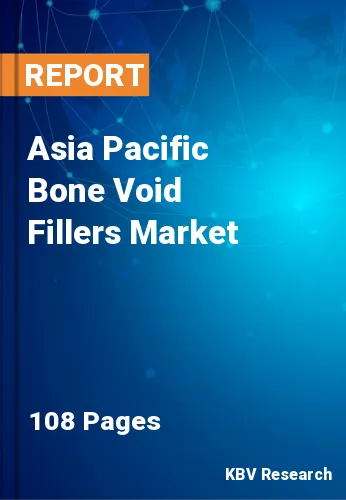The Asia Pacific Bone Void Fillers Market would witness market growth of 8.9% CAGR during the forecast period (2023-2030).
The osteoconduction, radiopacity, and ease of handling that Tricalcium Phosphate offers during void filling in dental situations are the key reasons why its use is expanding. Tricalcium phosphate ceramics' efficacy, as evidenced by research studies, is another element fueling the expansion of this market The possibility of using beta-tricalcium phosphate to regenerate infra-bony defects surrounding natural teeth in a periodontal setting. Similarly, it was suggested in the May 2021 issue of the Journal of Dentistry that utilizing TCP, or tricalcium phosphate 5, can reduce dental implant problems and failure. Consequently, the use of tricalcium phosphate ceramics for filling dental cavities is growing. During the projected period, voids are anticipated to accelerate the growth of this category in the market under investigation.
The elderly population frequently needs bone void fillers because of aging-related variables that can raise the risk of bone fractures and abnormalities. Older persons, especially women, are more likely to develop osteoporosis, which causes the bones to become fragile. As a result, the risk of fractures rises, necessitating the use of bone void fillers to maintain the structure and speed up the healing process.
Rapid aging in Asia and the Pacific has made the region the leader of one of the most significant demographic trends, owing to increased life expectancies and declining fertility rates. One in four individuals in Asia and the Pacific will be older than 60 by 2050. Between 2010 and 2050, the region's old age population (those above 60) will quadruple, reaching around 1.3 billion people. This transition will occur quickly in some nations, such as the People's Republic of China, Thailand, and Vietnam, while it will take longer in others, such as Indonesia, but these nations will still have very significant populations of elderly people. As a result, the requirement for bone void fillers in surgeries is being driven up by the growing geriatric population and diseases. As a result, Asia Pacific is seeing increased demand.
The China market dominated the Asia Pacific Bone Void Fillers Market by Country in 2022, and would continue to be a dominant market till 2030; thereby, achieving a market value of $391.5 million by 2030. The Japan market is poised to grow at a CAGR of 8.2% during (2023 - 2030). Additionally, The India market would exhibit a CAGR of 9.5% during (2023 - 2030).
Based on Type, the market is segmented into Demineralized Bone Matrix, Calcium phosphate Bone Graft Substitute, Collagen Matrix and Others. Based on Form, the market is segmented into Gel & Putty, Granules and Others. Based on Application, the market is segmented into Bone Fracture, Spine Fusion and Others. Based on End User, the market is segmented into Hospital, Specialty Clinics, and Others. Based on countries, the market is segmented into China, Japan, India, South Korea, Singapore, Malaysia, and Rest of Asia Pacific.
Free Valuable Insights: The Worldwide Bone Void Fillers Market is Projected to reach USD 6.1 Billion by 2030, at a CAGR of 7.9%
The market research report covers the analysis of key stake holders of the market. Key companies profiled in the report include Medtronic PLC, DePuy Synthes (Johnson & Johnson), Orthofix Medical, Inc., Stryker Corporation, Zimmer Biomet Holdings, Inc., Smith & Nephew PLC, NuVasive, Inc., Baxter International, Inc., Biocomposites Ltd., and Arthrex, Inc.
By Type
By Form
By Application
By End User
By Country
Our team of dedicated experts can provide you with attractive expansion opportunities for your business.

